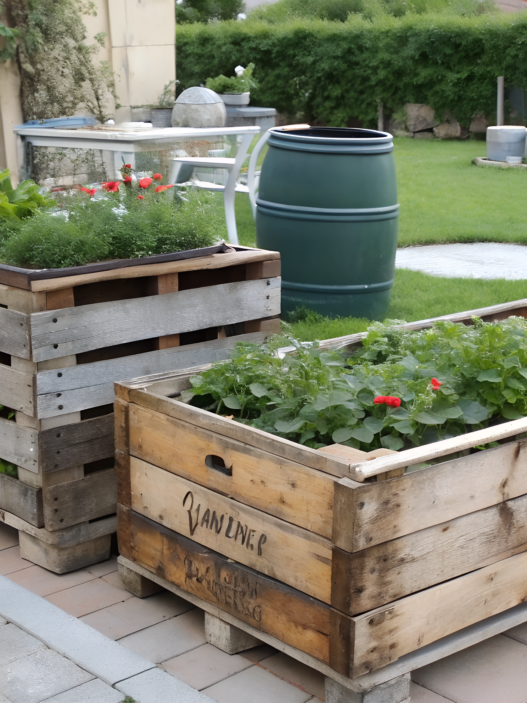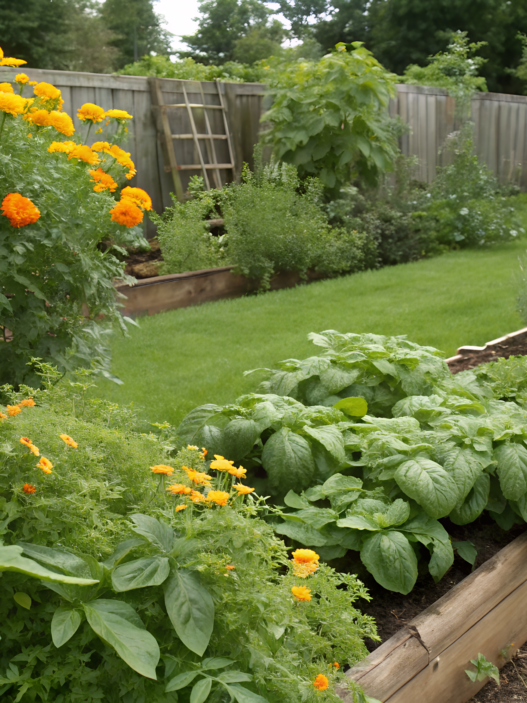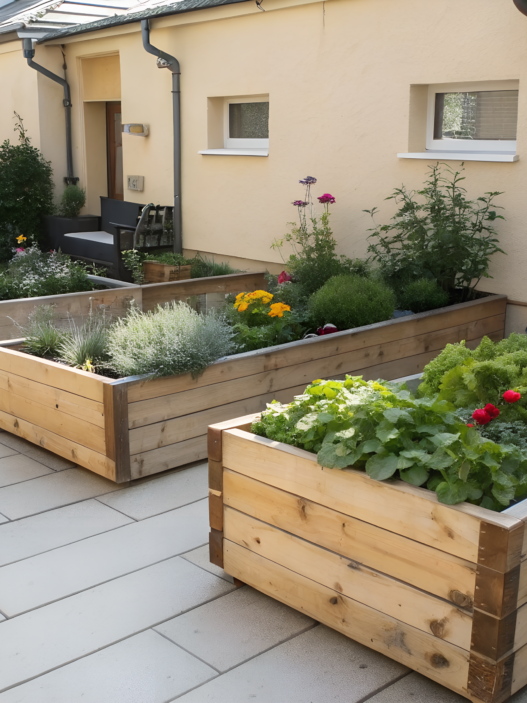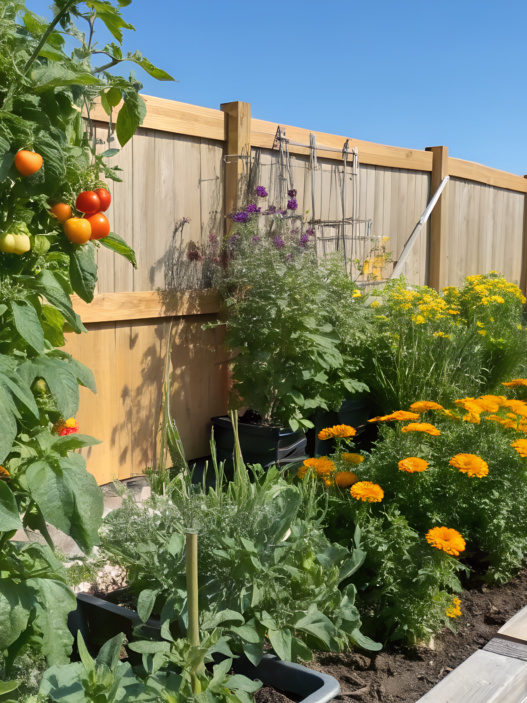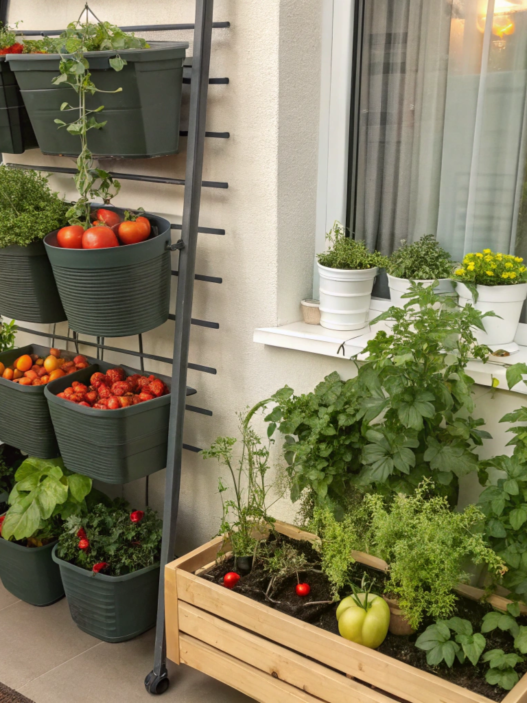Walking out into the yard, running your hand over fragrant basil, rosemary or thyme and cutting a fresh bundle for dinner… A dream? Well, it’s not! If you want to have a beautiful and convenient herb garden, here we’ll break down the best ways to design, plant and maintain a garden that will thrive all season long.
And it makes absolutely no difference whether you have a large plot or a small balcony, either way you can find the perfect solution.
How to Design an Outdoor Herb Garden That’s Both Aesthetic & Practical
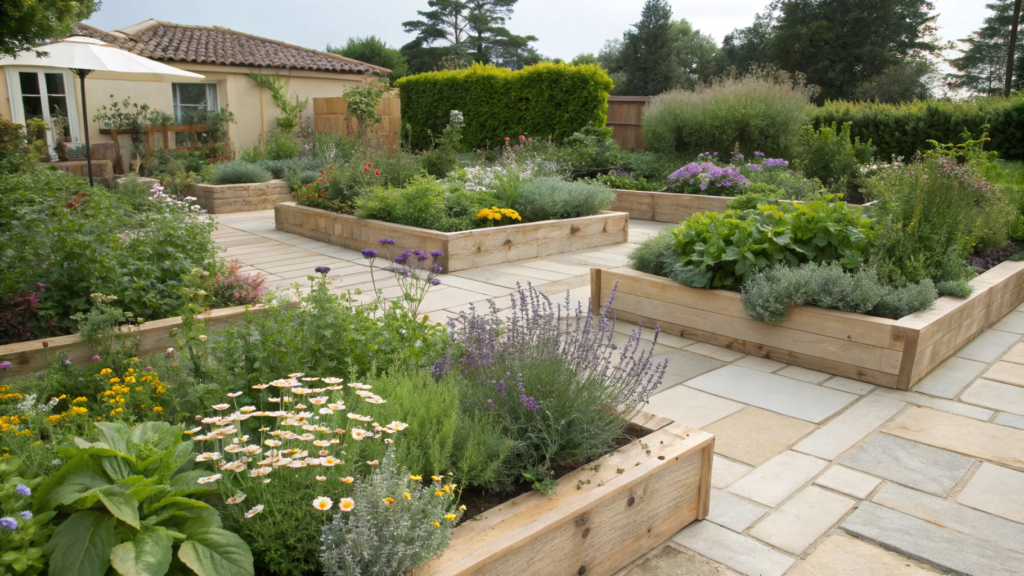
The perfect herb garden is always a combination of beauty and functionality. It should look like a picture from a magazine, but it should also be convenient and functional so that you have quick access to fresh herbs for cooking, making tea or natural remedies.
1. Choosing the right spot
Choose an area that gets at least 6 hours of direct sunlight a day. If space is limited, a vertical garden, hanging planters or tiered structures can help utilize the space efficiently. In hot climates, choose an area with afternoon shade to protect basil and cilantro from sunburn.
2. Determine the style
Your garden should harmonize with the space and reflect your taste:
Rural style. Plant a mix of herbs, flowers and vegetables to create a natural, slightly wild look. Lavender, chamomile and basil together? Yes, it’s beautiful!
Classic Formal Garden. Clear geometric patterns, stone paths and raised beds create an elegant composition. It looks like an old monastery or French kitchen garden.
Modern minimalism. Concise pots, neat rows and muted colors are perfect for urban spaces.
3. Accessibility
The closer the garden is to the kitchen, the more often you’ll use herbs. If possible, place beds or containers by the door or on the patio. Conveniently, this way fresh herbs are always at your fingertips.
4. Add decorative elements
Just a few small details will turn your garden into a cozy retreat:
Gravel or tile paths – help keep things clean and add a cozy feel.
Plant name plates – finally, no more guessing where things grow.
Decorative pots – choose terracotta for rustic style, matte black for minimalism or bright ceramic pots for contrast.
Trellises for climbing plants – not only functional, but also add height to the composition.
Tip. Place a bench or small seating area near the garden. I’m already anticipating how pleasant it will be to drink tea surrounded by the scents of lavender, peppermint and lemon balm.
The Secret to Growing Herbs Garden Outdoors That Last All Season
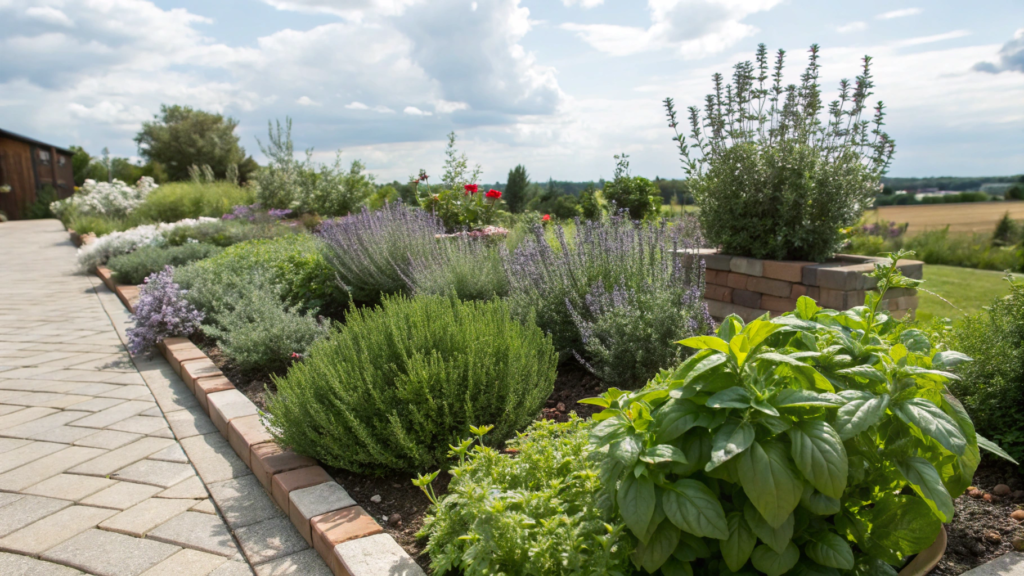
To prevent herbs from wilting in mid-summer, the garden must be properly cared for from the very beginning.
1. Good drainage is a must
Herbs don’t like wet roots as excess moisture leads to yellowing, wilting and even rot. If you have heavy clay soil, add sand or perlite for better drainage. Choose containers and pots with holes for water to drain.
2. Regular pruning stimulates growth
The more often you cut back the leaves, the faster the plant grows new ones. If you don’t prune basil or mint, they will start to stretch, lose their shape and bloom faster.
3. Plant together for protection and yields
Some herbs grow better next to each other:
- Basil + Oregano – enhances flavor and repels pests.
- Rosemary + Sage – like dry conditions and protect each other from insects.
- Thyme + Lavender – improve soil and attract beneficial insects.
Tip. Mulch the beds with straw or fallen leaves. This will retain moisture and reduce weed growth, especially in dry climates.
DIY Raised Herb Garden Beds – The Easiest Way to Grow More

Raised beds are the best way to increase your yields. They save space, make plant care easier and improve soil quality.
Why raised beds?
- Better drainage. Water doesn’t stagnate, roots don’t rot and plants feel better
- Less bending over. It’s easier to care for your plants, especially if you plan to harvest them regularly.
- Fewer weeds. Weeds do not penetrate the beds from below, reducing the need for weeding.
- Keeps the soil warmer for longer. The soil in such beds warms up faster in spring, so you can start planting earlier.
To make a bed in an hour you will need raw wood planks (cedar is best) or a metal bed, a drill and self-tapping screws for assembly, a quality soil mix (an ideal combination of 50% compost, 30% garden soil and 20% sand/perlite)
Because it’s easy to control soil conditions in these beds, they’re great for growing a wide variety of herbs. Here are a few of the best options:
- Basil. Loves warm soil and sun, and grows especially lush in raised beds.
- Sage. Prefers light, well-drained soil, which is easy to create in these beds.
- Oregano. Spreads quickly, and a raised bed helps keep it in one place.
- Thyme. Can’t tolerate excess moisture, and good drainage in the bed avoids root rot.
- Chives and parsley. Unpretentious, quickly regrow after cutting and feel great in raised beds.
Tip. Before backfilling the ground, put cardboard on the bottom. This will prevent the growth of weeds and retain moisture.
How to Keep Your Outdoor Herb Garden Thriving in Any Climate

Herbs have the ability to adapt in any climate, but only if given the right conditions. Fortunately, a few simple tricks can help your herbs stay healthy and productive all season long.
For hot climates
Too much sun can literally burn delicate herbs like basil and cilantro. But that doesn’t mean you can’t grow them!
- Create penumbra shade in the afternoon. You can do this by using garden netting or by placing herbs next to taller plants.
- Water less frequently but deeper. Surface watering will lead to a weak root system.
- Choose drought-tolerant herbs. Rosemary, thyme and oregano like dry conditions and can do without frequent watering.
For cooler climates
Frost can kill heat-loving herbs, but some crops can survive the winter and even get stronger.
- Mulch the soil. A thick layer of straw or leaves will protect the roots from freezing.
- Choose frost-tolerant herbs. Thyme, sage and chives will survive the winter and grow back in the spring.
- Carry tender plants inside. Basil, rosemary and parsley can be transplanted into pots and placed on a sunny windowsill until spring.
For humid climates.
Excess moisture is the main enemy of herbs. It causes fungal diseases and root rot.
- Leave more space between plants. This will improve air circulation and reduce the risk of mold.
- Choose disease-resistant herbs. Oregano, rosemary and sage are less susceptible to fungal infections.
- Water only in the morning. This way the leaves will have time to dry out by evening and won’t collect excess moisture.
Tip. In any climate, raised beds and well-drained soil make caring for herbs much easier.
The Unexpected Trick That Makes Herbs Grow Faster Outside
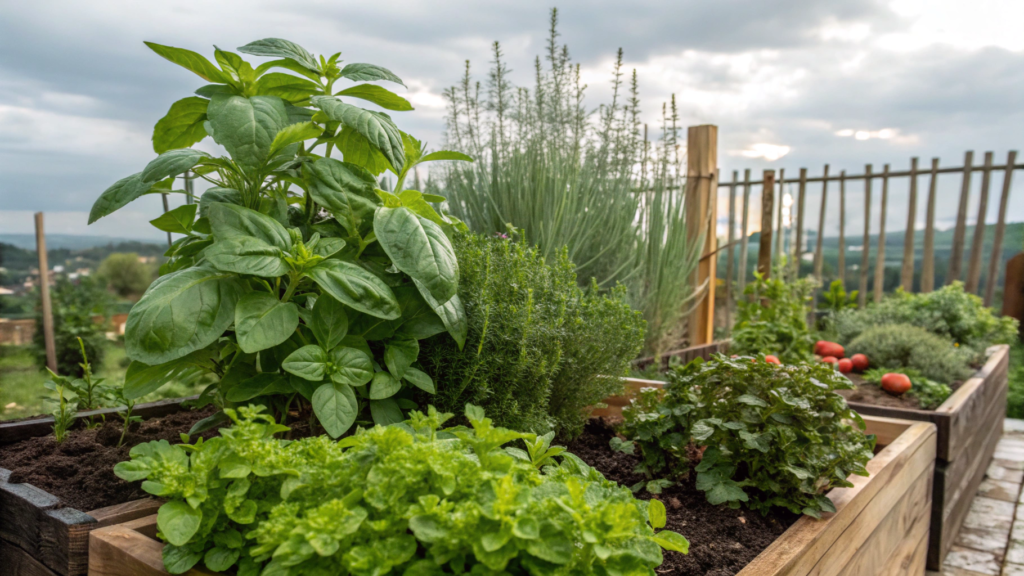
It’s nice to see herbs that grow faster, lusher and more flavorful. And that’s what companion planting is all about, and it’s the easiest way to speed up growth, improve flavor, and protect against pests.
The best pairs for growing together
- Basil + tomatoes. This neighborhood improves the taste of tomatoes and repels pests.
- Rosemary + cabbages (broccoli, cabbage, Brussels sprouts). The smell of rosemary drives away cabbage moths that destroy these crops.
- Velvet + any herbs. Velvets repel aphids, beetles, and nematodes, protecting the garden without chemicals.
Bonus Lifehack. The more often you cut leaves, the faster the plant grows. Regular harvesting stimulates new growth, so use your herbs with gusto.
Tip. For lush bushes, pinch the tops off basil, mint and oregano to keep them from stretching out.
Balcony Herb Gardens – How to Grow Fresh Herbs in Tiny Spaces

Even a small balcony can be transformed into a beautiful herb garden. Proper organization of the space will allow you to grow a lot of herbs even on a few square meters.
The best ways to organize a mini garden on your balcony
- Hanging planters. They take up minimal space and are suitable for ivy herbs like thyme and rosemary.
- Wall shelves. These shelves help save space and organize herbs in several tiers.
- Mobile carts. They allow you to move plants around depending on the light or weather.
Best herbs for balcony
- Basil – this herb grows great in containers but requires regular watering.
- Peppermint – it grows quickly, so keep it in a separate pot or it will take over everything!
- Chives – unpretentious and very easy to use.
- Thyme – drought tolerant and requires little care.
Tip. Self-watering pots will help keep things hydrated without the hassle. Try these models on Amazon, very convenient.
Best Herbs to Grow Outside for Endless Harvests

You can always find plants that are better suited for planting than others. These herbs grow well outdoors, consistently produce fresh herbs and look lush all season long.
Best Perennial Herbs. These herbs don’t need to be replanted every year:
- Thyme – Drought tolerant, unpretentious and flavorful.
- Oregano – loves sun and sprawls quickly.
- Rosemary – a classic Mediterranean herb that can grow for decades with proper care.
- Chives – you cut them off and they grow back!
- Sage – not only tasty, but also a natural pest repellent.
Best annual and biennial herbs (grow fast but require transplanting)
- Basil – oh, it’s the king of summer herbs. If you trim the tops regularly, the bush will be lush and productive.
- Cilantro – grows best in cooler seasons (plant in spring and fall).
- Dill – grows quickly and reseeds itself the following year.
- Parsley – a biennial plant: the first year gives greens, the second – seeds.
How to increase the yield of herbs?
The more you cut – the more it grows, because frequent pruning stimulates the active growth of new shoots.
Choose the right spot. Most herbs like sun, but some (like cilantro) prefer semi-shade.
Combine perennial and annual herbs. This way, the garden will always be green and productive.
Tip. Dry or freeze herbs to use throughout the year. Try special herb dryers on Amazon to preserve maximum flavor.
How to Design a Picture-Perfect Outdoor Herb Garden (No Experience Needed)

You don’t need years of experience to create a beautiful, neat and stylish herb garden. With a little planning, your garden will be perfect.
Step 1. Choose a centerpiece
The best gardens have a focal point – it could be:
A raised bed. It is convenient for planting and maintenance.
A tiered pot for herbs. Such as this one on Amazon, perfect for small spaces.
Spiral bed. Really looks very pretty and improves drainage.
Large decorative pot. Such a pot will definitely make the herbs stand out in the overall garden design.
Step 2. Play with height and texture
To make the garden look three-dimensional and lively, combine herbs of different heights:
- Tall herbs – rosemary, fennel, lemongrass.
- Medium herbs – basil, sage, lavender.
- Ground cover herbs – thyme, oregano, stem rosemary.
It is this approach that makes the garden lush and interesting, not flat and boring.
Step 3. Add decorative elements
Pots and containers – pick a style that suits your space.
Plant labeling – use wooden signs or slate tags.
Paths and borders – brick, stone or even recycled materials will give the garden a finished look.
Step 4. Think practicality
It’s easy to get carried away with beauty, but don’t forget functionality. Place your most used herbs close to the kitchen so you always have them on hand.
How to Use Pots for an Outdoor Herb Garden That’s 100% Portable

Potted herbs are ideal for patios and small spaces – they can be repurposed, moved into the house in winter or rearranged to suit the garden.
The best pots for herbs
- Terracotta pots are a classic option, they allow excellent air flow and prevent roots from rotting. But they dry out quickly, so they are suitable for dry-loving herbs such as rosemary or thyme.
- Fabric grow bags are lightweight, flexible and provide excellent drainage. Suitable for moisture-loving herbs like mint and cilantro.
- Self-watering containers – certainly the best choice for busy gardeners. The built-in reservoir maintains optimum humidity, which is especially useful in hot climates.
Tip. Use wheeled stands to move heavy pots around effortlessly. This is especially handy for moving plants closer to a sunny window or vice versa for moving herbs inside in cold weather.
The Best Outdoor Herb Garden Layouts – Which One is Right for You?

As you have already realized, there are plenty of options to organize your herb garden, but some layouts are more convenient and efficient. Here are some of the best options that will suit both large plots and small spaces.
Spiral Herb Garden
- This design not only looks stylish but is also beneficial for plants. The spiral allows you to place herbs with different moisture and sun requirements:
- At the bottom of the spiral, the soil stays moist – ideal for mint, parsley or cilantro.
- At the top of the spiral, the soil is dry and well-drained – great for rosemary, thyme and sage.
- This shape optimizes space and makes the garden visually interesting.
Tip. Put decorative stones between the herbs to emphasize the spiral structure and create a more natural look.
U-Shaped Raised Bed
This design is ideal for larger gardens as it increases planting space, makes it easier to access plants and reduces weeds.
- The center aisle gives easy access to all plants – you won’t have to bend or reach.
- Great for perennial and annual grasses, creating a multi-level composition.
- You can combine different heights of beds, which gives you the opportunity to create a more dynamic design.
Tip. Use different materials for borders – natural wood, brick or metal – to make the bed fit in with the style of your plot.
Container Clusters
If you have a small space, balcony or patio, this particular option is a good fit.
- Multi-sized containers allow you to create a tiered composition while saving space.
- Easy to move depending on the sun and the season.
Containers can be used of different materials:
- Terracotta – great for air flow.
- Fabric bags – provide perfect drainage.
- Self-watering containers – for busy gardeners.
Tip. Place tall herbs (rosemary, fennel) in the back and low herbs (thyme, oregano) in the front to create natural layering.
Which option you want is up to you, based on your preferences and capabilities.
And lastly
I think you now have the opportunity to create a beautiful, comfortable and cozy space that is a pleasure to spend time in. No matter which method you choose, you’ll always have flavorful and fresh herbs on hand all season long.
What herbs are you planning to grow this year? Share in the comments!








